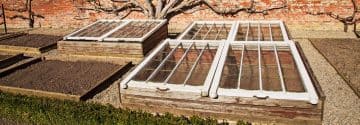Diagram shows relative size of different types of soil particle.
Loam
This is the easiest of soils to work with. Loamy soils contain a good mixture of sand and clay particles and humus. Loam is easy to dig and also retains plenty of nutrients. It has good drainage, but at the same time retains more than enough water to meet plant needs.
A loam soil provides conditions that suit the majority of plants.
Clay
As we have seen, clay particles are very tiny, clinging together easily and forming a dense, poorly draining mass. Soil containing more that 25% clay particles feels physically heavy to dig and is sticky to work after rain. Clay soils do not warm up quickly in the spring, and in hot, dry weather the clay shrinks as the moisture is lost. As a result the soil can bake hard with large cracks and fissures appearing on the surface. Clay soils are also prone to compaction where the particles become squashed together and there is little room for air or water to move between them. A compacted soil is hard and very difficult to work.
Some plants will not tolerate cold, wet clay soils in winter, and the structure makes these soils unsuitable for certain crops, such as carrots. However, its density means it holds on to nutrients well, and, if plants can tolerate the soil, they will often grow very well in clay.
Most root crops do best in a light, free-draining soil, where they can grow and expand easily. Root crops growing in a heavy soil are often small and underdeveloped because their growth has been restricted.
Harvesting root crops from a heavy soil is also hard work and unless care is taken the crops may be damaged as they are pulled up. The diagram below shows the way clay particles may settle in soil pores around larger molecules.
Silt soils share many of the same characteristics as clay soils.
Sand
Sandy soils are free draining so they rarely become water-logged. They warm up quickly in the spring. Digging is usually easy at any time of year. The main problem with sandy soils is that nutrients wash out easily through their loose structure and therefore they are seldom fertile. These soils also don’t support plants as well as a heavier soil and they are prone to wind erosion.
Stony, Peaty and Chalky Soils
In addition to the main types, soil is often described as stony, peaty or chalky. Stony soil often occurs where a rock outcrop is close to the surface and may have a clay, loamy or sandy base. Peaty soils are acidic and occur naturally in moorland areas. Peaty soils are often very fertile but may require drainage and liming to correct the acidity.
Chalky soils are usually alkaline, and while they suit a number of flowering plants they can be difficult to manage. In wet weather they are sticky, the layer of topsoil may be thin. They can be improved by adding plenty of organic matter.

